William Blake, Visionary Artist and Poet
Nowadays William Blake is celebrated as one of the greatest English artists and poets, but in his time he was ignored and dismissed by the artistic establishment. For all of his life he was tormented by visions; visions of the marvelous and terrifying walking among the mundane. From those visions he forged an artistic legacy that was utterly unique at the time, and which has influenced the direction of art ever since.
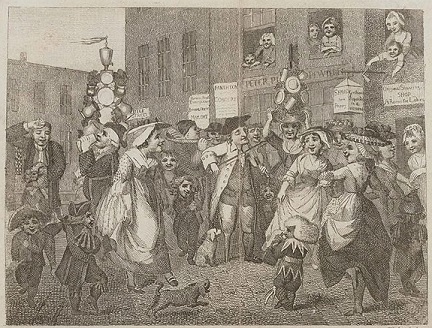
William Blake was born in November of 1757 in the city of London. His father had a business selling gloves and stockings, and the Blake family lived in the flat above his shop in Broad Street. He was the second of five children, and the business was able to support the family. In William’s case they recognised his artistic temperament early on, and so rather than formal schooling he was enrolled in a vocational school that aimed to produce commercially-oriented artists. They may also have realised he wouldn’t do well in a regular school as the young Blake was given to having “visions”, once nearly getting beaten for lying after he spoke about seeing angels. He continued to have these visions all his life.
When he was thirteen years old Blake was apprenticed to James Basire as an engraver. This involved making drawings and turning them into engravings on copper printing plates, or sometimes just copying existing drawings as engravings. It was hard work, but he enjoyed it immensely. This might have been to do with Basire’s specialty, which was in producing illustrations of medieval churches and monuments. Young Blake’s job often consisted of wandering around London’s old chapels making detailed drawings of old tombs and archways, which suited his temperament perfectly.
Engraving was difficult work, but it had little respect from the rest of the artistic world. At the time there was a strict hierarchy of artists. For example portraitists (who produced pictures of real people for pay) and landscape artists generally ranked lower than “pure” artists (who produced pictures of things like scenes from mythology or the Bible). The fact that the “pure” artists usually recycled the same compositions while the portraitists and landscape artists had to constantly produce new work is entirely besides the point, of course. (The real point was that the jobbing artists had to earn money, while the “real” artists could afford to produce non-commercial work.) Engravers, being extremely commercial, sat right at the bottom of the heap. And William was no doubt reminded of this in no uncertain terms when he completed his apprenticeship and became a member in the prestigious Royal Academy.
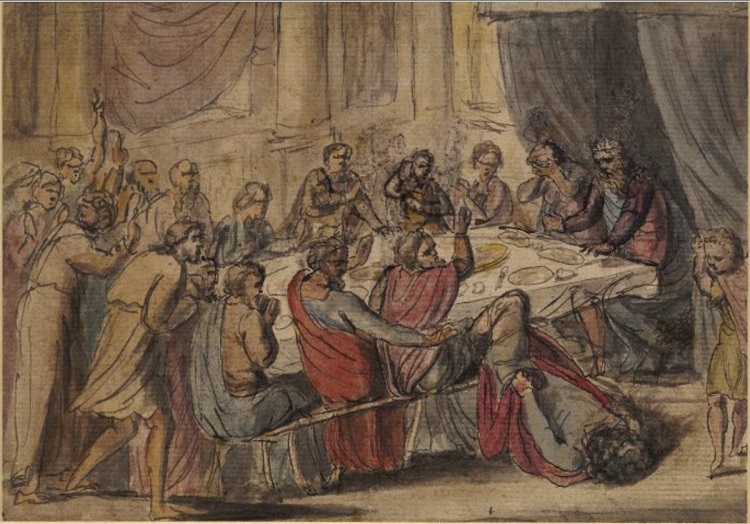
The president of the Royal Academy was Sir Joshua Reynolds. He was a portrait painter, and his incredible skill in this art had made him one of the most respected artists in England. This was one reason why he had been chosen by King George III as the first head of the Royal Academy of the Arts. Another reason was his phlegmatic temperament. He got along with everyone, perhaps a necessity for the head of an organisation responsible for training people so notoriously fractious as artists. But one person who did not like him was Blake. This was down to how the academy treated engravers. Originally they hadn’t been allowed to enroll at all, but Reynolds had been persuaded to allow six to join as associate members. They still weren’t allowed to become full members, and they were expected to be grateful to be there at all. This was practically guaranteed to rub someone like William Blake the wrong way, and he had a lifelong contempt for Reynolds’ “hypocrisy”.
One notable incident during Blake’s time at the academy was when he got caught up in one of the many anti-Catholic riots that swept the city following the relaxation of laws that prevented Catholics from inheriting land. Though that was the initial cause of the rioting, many who joined in did so because they supported other anti-establishment causes like removing the property requirement for voting, or American independence. William, who wound up enthusiastically joining in on an attack on Newgate Prison, later took the latter as his justification. He was an enthusiastic supporter of America later in life, and treasured the idea that he had joined in their “spirit of rebellion”.
Washington spoke: ‘Friends of America! look over the Atlantic sea;
A bended bow is lifted in Heaven, and a heavy iron chain
Descends, link by link, from Albion’s cliffs across the sea, to bind
Brothers and sons of America; till our faces pale and yellow,
Heads depress’d, voices weak, eyes downcast, hands work-bruis’d,
Feet bleeding on the sultry sands, and the furrows of the whip
Descend to generations, that in future times forget.
– America: A Prophecy.
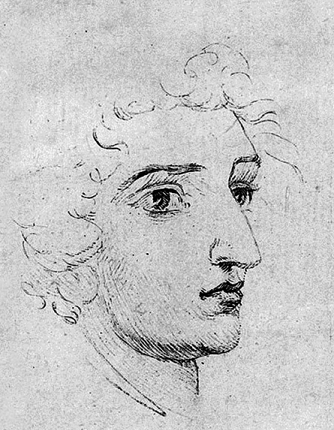
In 1781 William courted a young woman named Polly Wood, but when he proposed marriage she turned him down as she had not yet decided which of her suitors to marry. William was upset at this, which caused Polly to laugh in his face and call him a fool for his jealousy. He was very upset at the time, but he later admitted that she was in the right. He was so upset at the time that he felt the need to abandon his usual surroundings, and took a holiday to Battersea. He stayed in the house of a man named William Boucher, and found a sympathetic ear in the man’s daughter Catherine. He asked her if she felt sorry for him, and she said yes. “Then I love you”, he replied. They were married in August of 1872.
William later regarded his marriage to Catherine as the best thing that ever happened to him, and she was a solid support to him for the rest of his life. The practical Catherine was exactly what the somewhat disorganized William needed to keep his life on an even keel. She was also intelligent and diligent, and became as much William’s assistant as his wife. This expertise was well-timed, as after the death of his father in 1784 (and the end of his studies at the academy) William set himself up in business as a print-seller. The business did not last long, as William argued with his partner and wound up dissolving the firm. Then in 1789 his first “real” book, Songs of Innocence, was released. [1]

Songs of Innocence pioneered the iconic appearance of Blake’s books, where text was intertwined with images on the page. This meant that they were not printed; instead each page was engraved, impressed on the page, and then carefully hand-coloured. This has been described as a modern successor to illuminated manuscripts, and the process was so labour-intensive that nobody has duplicated it since. This was also a major factor in why Blake never enjoyed great success in his lifetime, as it severely limited the number of copies he could produce while increasing their cost. In fact only 22 copies of Songs of Innocence were actually produced. In a very real sense it was less a book, and more a limited run of a work of art where the words only formed part of the creation.
The primary theme of Songs of Innocence was childhood, which Blake portrayed as a time of imagination and, naturally, innocence. It was a reversal of the traditional children’s book where wise adult preach morals to children, and instead had the children preaching to the adults. There were threads of social consciousness woven through it as well, with one of the children who give their wisdom being an African slave and another being a chimney sweep. The first laments that his skin colour disguises the fact that his soul is the same as any other child; the other tells a friend of a vision that if they are good they will be allowed to play like normal children in heaven. This level of awareness about social issues isn’t that surprising, as he was engraving illustrations for clients like Mary Wollstonecraft at the time.

Five years later Blake added a second section to this book and renamed it Songs of Innocence and Experience, where the earlier work was contrasted with poems based on coming to understand the world around you. This is the collection that includes one of his most famous poems, The Tyger. As befits the subject matter, it was even more socially conscious than “Innocence” had been, though by now the bloody Terror following the French Revolution had tempered Blake’s enthusiasm with cynicism. He still remained staunchly committed to progressive causes like the abolition of slavery, and would for all of his life. Indeed many of the poems in Songs of Experience deliberately continue and contrast themes from Songs of Innocence; most explicitly in two poems with the same name: The Chimney Sweeper. In Experience the young chimney sweep laments that his carefree childhood has now been transformed into misery in order to make other people’s lives easier.
This period in the early 1790s may have been Blake’s most creative period, and was when he produced many of his most famous works. These are sometimes collectively known as his “prophetic” works and were heavily influenced by his involvement in Swedenborgianism, a semi-religion based on the philosophy of Emmanuel Swedenborg. Most explicitly influenced is The Marriage of Heaven and Hell, which takes the Swedenborgian idea that the material world is where Heaven and Hell meet and combines it with Blake’s own beliefs. To Swedenborg “Heaven” was ideal and “Hell” was reprehensible, but in Blake’s view “Heaven” represented organisation and “Hell” represented energy. The two had to work together to change the world.
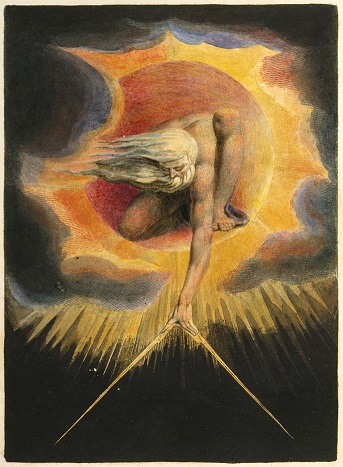
The Continental Prophecies are where the “prophetic works” take their title from. They were a trilogy that covered four continents; the third book The Song of Los is divided into two halves: Africa and Asia. Illuminated books of etchings like all of Blake’s completed works, they tell the story of the god Orc as he travels the world. Orc is the spirit of rebellion, who stands in opposition to the creator and God of Order Urizen. This was a mythology that Blake would continue to refine through his later works, but in these books Orc simply symbolizes the spirit of the American revolution that inspired the French one. Those two revolutions are the themes of America and Europe. The Song of Los is less tied to its continents, and is mainly about these physical revolutions transforming into spiritual and mental ones.
This creative period came to an end around 1793, as the British government began to crack down on anything considered “revolutionary”. They had no wish to go the way of France, and the printers who hired William to do their illustrations were the subject of their scrutiny. This put a great deal of stress into William, and he became convinced that his books were so filled with revolutionary power that he was at risk of being executed. (His paranoia was the salvation of his friend Thomas Paine. William warned the influential writer of his impending arrest in time for him to escape to France.) Blake’s worries for himself vastly overestimated both his reach and his comprehensibility, but it was enough to scare him away from political works and more towards the mystical.
This primarily took the form of The First Book of Urizen, an expanded examination of the mythology he had begun in America. In Blake’s cosmology Urizen was a fallen angel, blinded and cast out, who had created the material world as a place of laws and rules that he could control. For this crime Urizen was imprisoned by the angel Los, who wept out of pity for him. A woman was borne of the tears, and she had a son (Orc) by Los. Orc’s cries awoke Urizen who travelled the world and despaired at the inability of humanity to follow the laws he had laid down. In response he creates religion as a “chain for the mind” that he could use to control them.
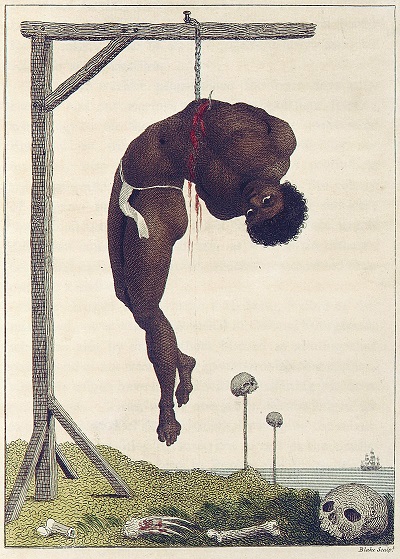
This was a story that Blake would revise and revisit many times over the next decade. Unlike his burst of creativity at the start of the 1790s, Blake now slowed down his personal creativity and took his time over his works. This was in part due to professional success, though the jobs began to dry up towards the end of the decade. Times were hard for the Blakes, so it was a relief when William was offered a job by the poet William Hayley illustrating a biography of Hayley’s recently deceased friend William Cowper. The job involved moving to Sussex to be closer to Hayley’s country home. So it was that William and Catherine packed up and, for the first time in William’s life, moved out of London.
Their new home was in the village of Felpham in Sussex, on the southern coast of England. Blake had never lived by the beach before, and he wrote a poem in a letter to a friend describing the vision he had walking on the sand in the sun.
Over sea over land
My eyes did expand
Into regions of air
Away from all care.
Into regions of fire,
Remote from desire,
The light of the morning,
Heaven’s mountain adorning.
Blake had been suffering from depression in London, and this new location seems to have revitalised his spirit. The job proved less agreeable, though. Hayley was a good man and meant well, but he was one of those extroverted personalities who finds it impossible to imagine that anyone else isn’t as extroverted as him. To someone like Blake, who had a fairly severe upper limit on how much socialisation he enjoyed, it was a tough situation. Plus, as he soon discovered, depression is not easily escaped simply by changing location. It was only through Catherine’s support that he bore up under the pressure.
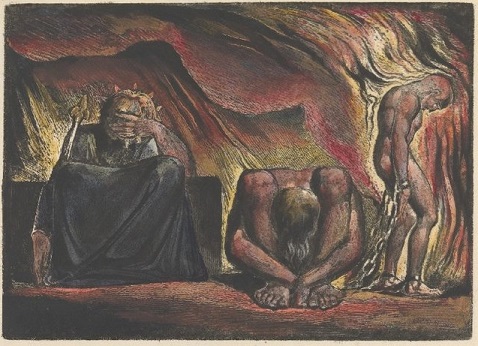
Blake’s rural idyll was ruined in 1803 by a sudden crisis. A soldier from the local barracks named John Schofield wandered into Blake’s garden while drunk one night, and then argued with Blake when he tried to throw him out. Eventually Blake managed to make him leave, but Schofield took his revenge by claiming that Blake had said “Damn the king! The soldiers are all slaves.” during the argument. This led to Blake being put on trial for sedition, the very thing he had been having nightmares about a few years previously. Though he was almost immediately declared innocent, it was still a deeply stressful event.
This stress was exactly what Blake didn’t need. Apart from his depression, his mental stability had always been tested by the visions he had continued to have since childhood. It’s always a fool’s game to try to diagnose the mental issues of historical figures, but it’s definitely clear that William Blake suffered from some form of (generally benign) type of illness. Hayley thought that he was “on the verge of insanity”, and credited Catherine with having kept him sane. But still the visions came. And after the unfortunate Schofield affair, the “messengers from Heaven” he saw had a clear message for him. Return to London, and return to the artistic works that he had abandoned.
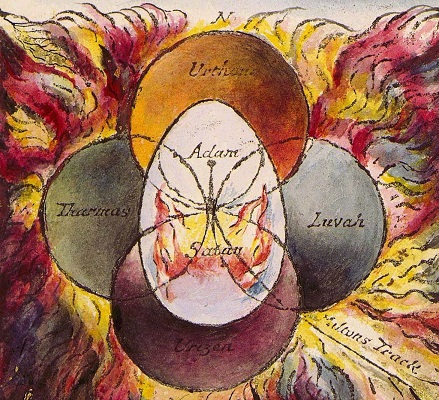
He hadn’t really abandoned them, though. He hadn’t been creating his relief etchings, but during his time in Felpham he had worked on an epic poem called Vala, or the Four Zoas. This told the story of four creatures called Zoas who rose from the fallen angel Albion, one of whom was Urizen (from his previous works). This was probably his most ambitious work, and one he would never properly finish. From it came the works that defined the second half of his career, Milton and Jerusalem.
If his work on Vala was the tinder, then the spark that reignited Blake’s artistic passions was the Truchsessian Gallery. At this time art galleries were practically unknown in England, and most paintings languished in private collections. The Truchsessian Gallery was a rare chance to see a great amount of continental art, nine hundreds works originally from Italy to the Netherlands, in one single place. They were the property of a Count Truchsess of Austria, who was trying to sell them to the government and hoped to get public support by putting them on display. In fact, most of the works were forgeries. The Count himself was probably a fake too; “Truchsess” was not a German name but a title of the nobility so his name essentially meant “Count Count”. But though the paintings were fake they were real enough to have a huge effect on Blake, leaving him “enlightened with the light I enjoyed in my youth”.

To see a world in a grain of sand
And a heaven in a wild flower,
Hold infinity in the palm of your hand,
And eternity in an hour.A robin redbreast in a cage
Puts all heaven in a rage.
– The opening of Auguries of Innocence
Prior to beginning work on these pieces though, Blake wrote one of the best known poems of his later career. Auguries of Innocence was never intended for publication; at least not in the form it’s recorded. The structure suggests that it may have been meant as the seed of another illuminated manuscript but the broad nature of its images didn’t fit with the narrow focus of Blake’s mythmaking at the time. Still, the lyrical beauty of the poem ensured that when it was published over 25 years after Blake died it immediately seized the imagination. Lines and images from the poem are still quoted or taken as the inspiration for titles to this day.
It was during this time that Blake also wrote what are probably his most famous lines, though their history is somewhat confusing. In 1804 he began work on two major pieces, the prophetic volume “Jerusalem” and the epic poem Milton. Jerusalem is a part of Blake’s myth-cycle and is about how the body of the fallen giant Albion (who is the spirit of Britain) gave birth to a woman named Jerusalem (spirit of the city of the same name). The four Zoas appear, as do druids, Jews and a Christ who is probably not Jesus. Overall it is one of Blake’s more impenetrable poems and ends with all life recombining into one great divine body. [2]
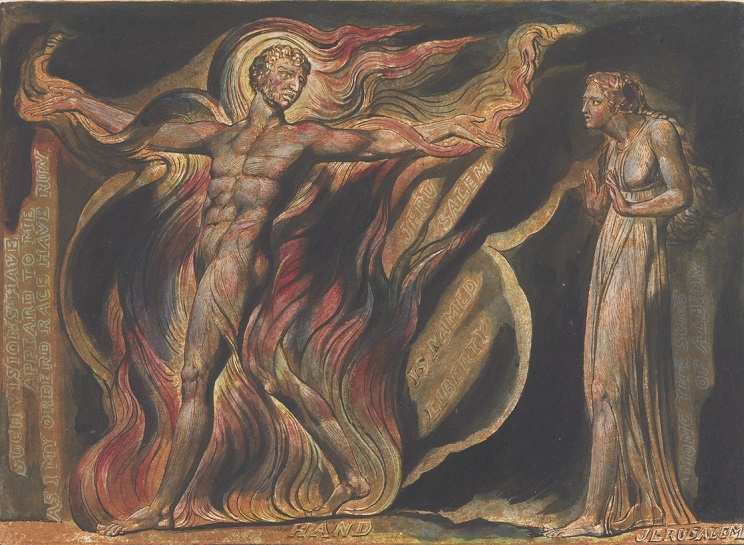
Milton is much more straightforward by comparison. The ghost of John Milton (author of Paradise Lost) returns to Earth and possesses Blake’s foot in order to pass on a prophecy he had heard in heaven. The ghost takes Blake to his cottage in Felpham, where an angel in the form of a bird reveals itself to be the feminine aspect of Milton. The two unite and achieve spiritual perfection.
And did those feet in ancient time,
Walk upon England’s mountains green:
And was the holy Lamb of God,
On England’s pleasant pastures seen!
The confusing thing is that the preface to “Milton” is well known to almost every British person; but it’s known under the title of “Jerusalem”. This is because it was almost completely unknown until it was taken from “Milton” and published as a stand-alone poem in a book of patriotic verse during World War 1. It was set to music by Sir Hubert Parry under the title of “And Did Those Feet”, and after the war it became associated with the Suffragette movement. In order to show his support for that, Parry assigned the copyright over to a Suffragette group. In the century since it has become better known as “Jerusalem” and is a feature of many large public events in England.
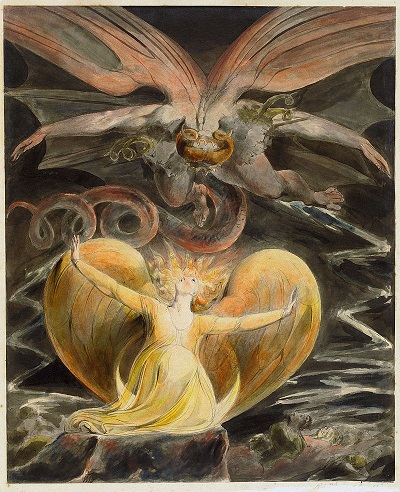
The actual Jerusalem took Blake sixteen years to complete, and he worked on it in parallel with Milton (which was published in 1810). This was during a turbulent time for Blake professionally. In 1805 he produced some of his most famous works, the “Red Dragon Paintings”. They were part of a series illustrating books of the Bible, and covered the Beast of the book of Revelations. Also in 1805 he designed the illustrations for The Grave, a poem by Robert Blair. But the work of creating the engravings (which was where the money was) went to a professional rival named Luigi Schiavonetti. In 1808 Blake pitched an idea to the same publisher of creating an illustrated version of the Canterbury Tales by Chaucer. The publisher liked the idea, but thought that Blake was too eccentric to make a commercial work. So he commissioned Blake’s friend Thomas Stothard to design the illustrations and Schiavonetti to engrave them. Blake never forgave Stothard for accepting the job and it was the end of their friendship. Blake tried to salvage his own ideas by having an exhibition at his brother’s shop, but not a single work was sold. Nowadays the estimated value of the art in that exhibition would be in the millions.
The 1810s are a fairly obscure period in William Blake’s life. Partially this is due to him not getting involved in any great quarrels during this time, and partly it is due to a historical tragedy that came later. We know he found some work engraving illustrations for encyclopedias, which were popular at the time. It would have been around this time that he and Catherine would have faced the fact that there would be no late miracle and that their marriage would remain childless. This was the one blot on their otherwise perfect partnership, and one which hurt both keenly. In the earlier years of their marriage (influenced by Swedenborg’s writings) William had suggested bringing a concubine into the house to bear a child for them; but he had dropped the idea when he saw that it had genuinely upset Catherine. So they accepted their situation while hoping for a miracle that, in the end, never came.
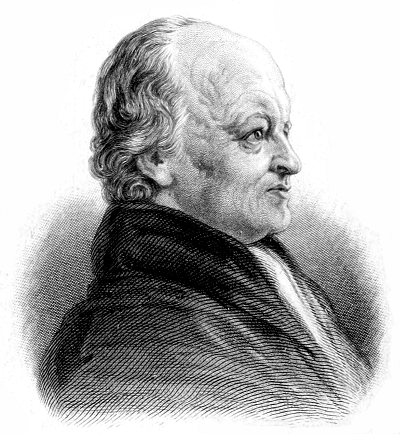
In 1818 William was introduced to a young artist named John Linnell. Though he was thirty-five years younger than Blake, Linnell shared Blake’s distrust for new innovations in art and the vagaries of what was “fashionable.” He had also trained as an engraver, which might have led Blake to trust him more. Linnell gave Blake some work engraving his paintings, and went with him on trips to museums and art galleries. Since Linnell admired Blake’s work he found several new clients for him, and also introduced him to his artistic friends. This was the beginning of the “Shoreham Ancients”.
The Shoreham Ancients were (despite the name) a group of young artists in their twenties who united in their belief that modern society was inferior to their idealised vision of a rural past. They expressed this through using old-fashioned forms of art, and could be considered a precursor to the Pre-Raphaelites. Their politics were wildly different from Blake’s, but they had a genuine admiration for his art which (like them) eschewed the fashions of the day. Given how little recognition Blake had during his lifetime, this was alike water to his parched soul.
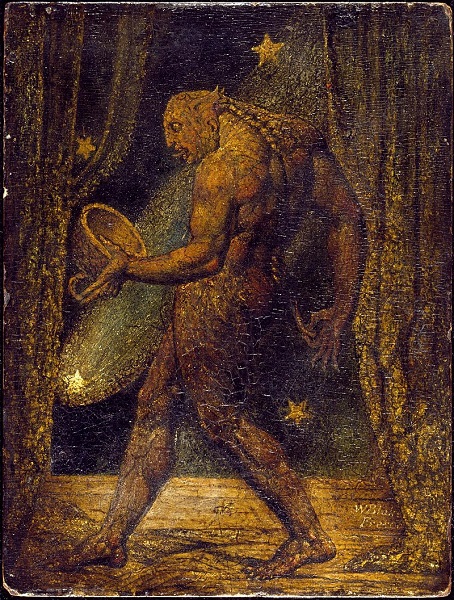
Linnell also introduced Blake to Cornelius Varley, who became one of Blake’s closest friends in his later years. Like Blake he was a mystic, and he was fascinated by Blake’s visions. The pair played a game where Varley would hold a seance to summon the ghost of a long-dead historical figure and Blake would draw his resulting vision. This led to the series of sketches known as the “Visionary Heads”, which have titles like Richard Couer de Lion and “he Man Who Built The Pyramids. The most famous of these is The Ghost of a Flea, which Blake turned into a full painting. It shows a hideous half-lizard creature holding a bowl of blood, a unique creation which has influence both literary and cinematic monsters ever since.
These new friends and admirers gave Blake the confidence to finally finish and publish Jerusalem. Only ten copies were ever printed; six during Blake’s lifetime and four after his death by Linnell. Blake only coloured two of them, and luckily one of those has survived in its entirety. Shortly after this poor finances forced William and Catherine to move to a small apartment in Fountain Court. There Blake lived for the rest of his life, and ill health meant that he rarely went out. People came to him instead, including a former artist turned writer named Thomas Griffiths Wainewright. The future convicted fraudster (and suspected poisoner) Wainewright was among the few contemporary journalists who wrote well of Blake during his lifetime.
There were two main projects that Blake worked on during his time in Fountain Court. Both were commissions from Linnell. The first was a set of illustrations for the biblical Book of Job, which had been an influence on Blake since childhood. It’s ironic that this, his last completed project, was the one which finally brought Blake the recognition he deserved. Both the Royal Academy and the King’s Library bought a copy for their collections, and this led to Blake being introduced to literary celebrities like Coleridge and Lady Caroline Lamb. It was this attention that would eventually lead to Blake’s posthumous fame.
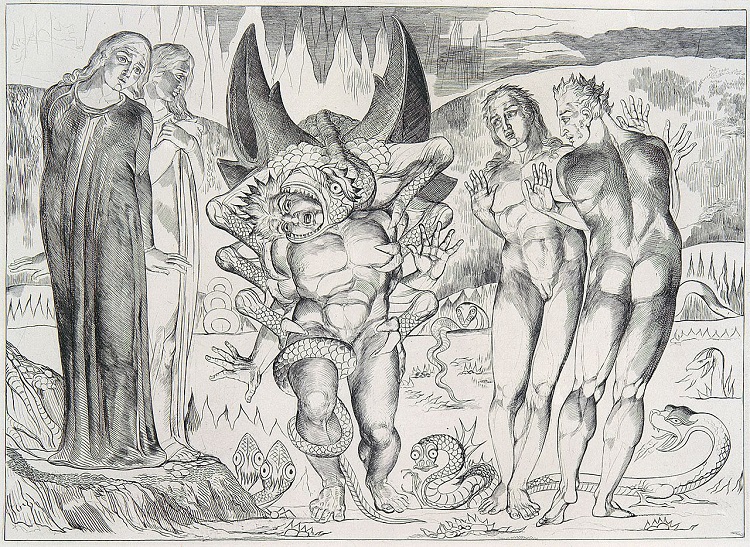
The second project, which Blake sadly never finished, was a set of illustrations to Dante Alighieri’s Divine Comedy. The work had only been translated into English relatively recently, but it struck a major chord with Blake. Here was something that shared his own vision, a fellow spirit. Blake’s illustrations for Comedy are less showing Dante’s vision and are more a collaboration. Blake added his own interpretation and vision in sympathy with the original, combining the two into something more.
Though Blake worked on Comedy up until his death, it was not the last thing he drew. On the afternoon of the 12th August, 1827, Blake was lying sick in bed. It was clear both to himself and Catherine that he was dying. William Blake looked at his wife and said: “Stay Kate! Keep just as you are – I will draw your portrait – for you have ever been an angel to me.” He sketched her, his final work, and then he lay down on his bed. His final words were a promise to her to be with her always.
Linnell paid for Blake’s funeral, which was sparsely attended. Afterwards Catherine moved into the house of Frederick Tatham, a member of the Shoreham Ancients. Officially she was a housekeeper; unofficially Tatham was providing her with room and board in exchange for the control of her husband’s artistic legacy. When she died in 1831, he insisted that she had left all of Blake’s writings and drawings to him. The other Ancients objected, since Blake still had a sister living, but they were unable to get Tatham to give up the manuscripts. This then led to an artistic and historical tragedy when Tatham joined a fundamentalist Christian sect. He decided that most of Blake’s work was heretical and destroyed it. Since he had been selling it off since Catherine’s death and hadn’t kept records of what he sold there is still a chance that some missing pieces may surface, but it is definite that Tatham destroyed a great deal of irreplaceable work.
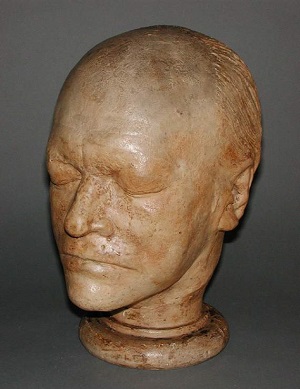
Blake remained largely obscure after his death until the publication in 1863 of The Life of William Blake. The book had been written by Alexander Gilchrist but he died before completing it. It was finished by Dante Gabriel Rossetti and his brother William Michael Rossetti, and the strength of the Rossetti name was a large part of why it initially sold well. The other part was Gilchrist’s thoroughness; he still had access to the Ancients and others who had known Blake during his lifetime. Rossetti worked mostly on the second volume, which was an anthology of Blake’s poetry and drawings. Through this a new generation of creators were exposed to Blake’s genius. His influence spread and grew throughout the 19th and 20th centuries until by the middle of the 20th century he was rightly considered one of the giants of English literature. He had never been appreciated in his lifetime, but like all true visionaries it took time and distance to understand quite how great he was.
Image via wikimedia except where stated.
[1] A book of his poems called Poetical Sketches had been privately printed by some of his friends in 1783, but William didn’t regard it as a real work of art.
[2] Any similarity to the end of a famous anime series is probably just a coincidence. Don’t worry about it.
